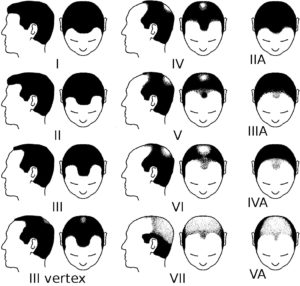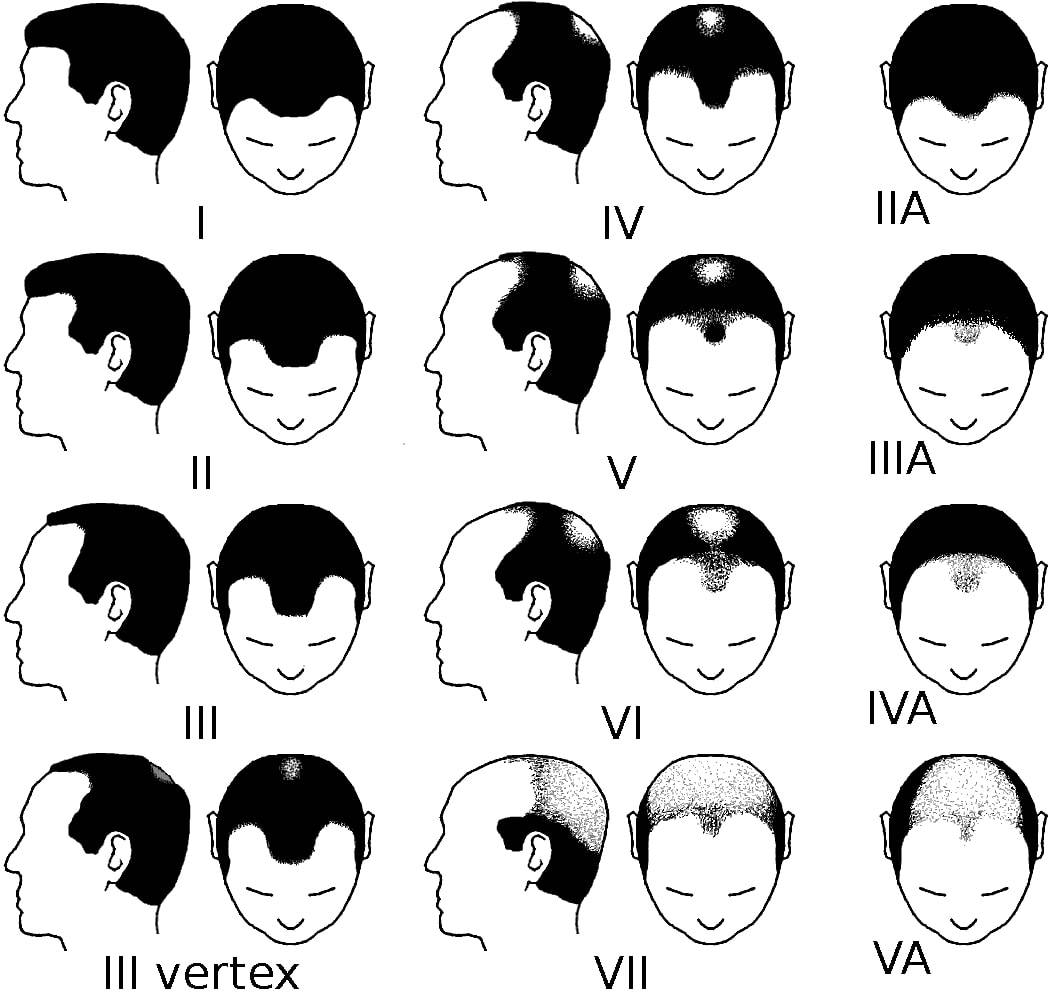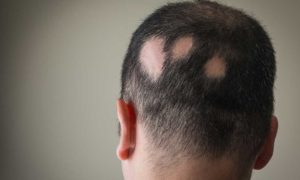Ever asked yourself how our surgeons categorise the different severities and stages of baldness? Have you ever wondered why so many men seem to suffer with hair loss in the same places? Well, here you can find out why.
On this page, you’ll find out why men suffer with hair loss, how clinicians diagnose baldness, and what men can do to fix a receding hairline. You will also find out how the Norwood Scale is used by clinicians.
What is the Norwood Scale?
The Hamilton Norwood scale is a classification system used by hair transplant surgeons to gauge levels of male patter baldness amongst hair loss patients. Split into seven stages (1 being a full head of hair and 7 being the most severe stages of hair loss), the Norwood scale is a common tool used by a hair loss specialist to diagnose a patient’s patterned hair loss and devise which surgical procedures are going to be most effective in promoting new hair growth.

As can be seen in the image above, the seven stages of baldness, according to the Norwood scale, proceed as follows:
- No receding or hair loss has taken place.
- The hairline recedes slowly and begins at the temple. Sometimes, this is called a “mature hairline“.
- Clinically significant hair loss becomes present. Hair has almost fully receded from the temple area and looks like an M, V, or U shape. Hair loss also slowly takes the top of the scalp, or “Vertex” (see 3V).
- Hairline recedes even further and vertex area becomes more sparse with hair.
- Only a narrow of corridor of hair is present between the temple and vertex areas of baldness.
- Vertex and Temple areas conjoin leaving full baldness on the top and front of the head. Hair only remains around the sides and back of the scalp.
- Only a band of hair remains around the sides and back of the scalp.
Depending on where you fall in the Norwood scale helps hair transplant surgeons to work out what type of hair transplant you may require. For those at the initial or medium stages of pattern hair loss, FUE hair transplants should often suffice. This process is minimally invasive. However, more severe stages of hair loss may require an FUT hair transplant.
Norwood Scale Stage 1
Stage 1 of the Norwood scale doesn’t actually show any hair loss at all. This shows how hair typically looks during adolescence. The hairline and crown show no sign of recession and hair looks full and thick on top.
At this point, catching hair loss early may negate the need for a hair transplant straight away. If you were to speak with one of our qualified clinicians, we may recommend a hair loss medication that is designed to slow down the signs of hair loss. Medications such as Finasteride and Minoxidil are DHT blockers meaning they can help stop hair loss whilst you take the treatment.
Stage 2
Sometimes referred to as the adult hairline, this is where a receding hairline first becomes present. The hairline begins to receding upwards from the brow crease. At this stage, surgeons are still unlikely to recommend a hair transplant. Like stage 1, the recommended treatment course is still Minoxidil and Finasteride.
Stage 3
The third stage on the Norwood scale is what can typically be defined as early male pattern hair loss. This is where further hair loss takes place beyond the “adult” or “mature” hairline as noted in stage two.
At this stage, your hairline will recede further up the temples causing a frontal tuft at the front of the head. Generally speaking, patients also feel that their hair begins to thin or feel finer to the touch.
At this stage, surgeons may begin to recommend a hair transplant as an option. However, this will dependent upon your family history, as this is the best indicator as to how your pattern hair loss is most likely to progress. Although, a hair transplant is a long-term solution to pattern baldness, it is important to consider how your hair will look in the future.
Stage 3 (Vertex)
Sometimes called the type iii vertex, this stage can be seen as an extension of stage 3. This refers to hair loss in the crown area alongside further losses in the temple region. The difficulty with crown balding is that it the balding area will expand greatly over time. This is why men under the age of 45 are unlikely to be granted a crown transplant. If a younger man goes to a hair transplant clinic with crown balding, a premature crown transplant could cause isolation. This is where a bald circle can begin to develop (between the transplant area and remaining healthy hair) as pattern hair loss continues.
If younger men are suffering with the effects of crown baldness, surgeons often recommend hair loss medication to slow down the effects.
Stage 4
As the Norwood scale progresses, the pattern baldness continues. Hair loss in the crown and temple areas continues, with a small amount of remaining hair between the balding areas.
As patients begin to reach this stage, it is generally wise to assume that they are likely to progress onto stages 5, 6, and 7. At this stage, surgeons generally recommend a forelock transplant. This helps patients keep a permanent hairline.
Stage 5
By the time you pass to stage 5, there is only a small corridor of hair from keeping the crown and hairline hair loss from meeting. Natural hair growth in the temple and crown will have ceased and little or no hair will be found here.
At this stage, a FUE hair transplant will likely be recommended where there are plenty of hair follicles that can be extracted form the donor site and be implanted into your bald areas.
If left untreated at this stage, pattern hair loss will continue and the cost of a hair transplant will increase. This is because more hair follicles are needed to be transplanted.
Stage 6
When a patient reaches stage 6, this is classed as a severe form of balding. Both balding areas, from the temple and vertex, have met causing full baldness form the top to the front of the head.
At this point, a FUE hair transplant can still be used to treat baldness. As the remaining hair is still fairly high upon the head, a hair transplant surgeon can perform a hair transplant in order to provide coverage of the areas of hair loss.
Stage 7
Stage 7 on the Norwood scale is the most prominent form of pattern baldness. At this point, full hair loss will have occurred on the top and front of the head, leaving only a thin strip of hair at the back and sides of the head. The main difference between stage 6 and 7 is a lowering, or dipping, of the backs and sides.
At this stage of hair loss, any form of hair transplant can be quite difficult in order to achieve full coverage and density. Obviously, given that there is less hair to work with than earlier stages, there is a much larger area of baldness to cover making the surgeons job quite difficult and most likely choices will have to be made over coverage and density.
At this stage, 2 or even 3 hair transplants would be needed should the donor area allow it.
Summary
To conclude, when deciding on a hair transplant, looking at the various Norwood stages of hair loss is important because it can give you an indication of where abouts you are on the Norwood scale and what is achievable when taking into account coverage and density. It’s always a case of working with surface areas. The size of the surface area of the area(s) of hair loss vs the surface area and availability of your donor area where extracting enough hair from the donor area will cover the recipient area AND leave enough hair in the donor area for it to look as full as possible.







